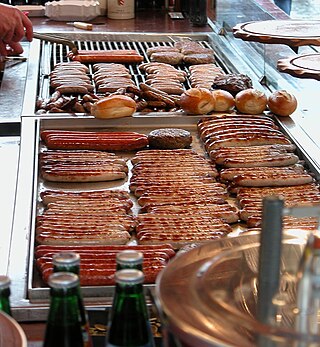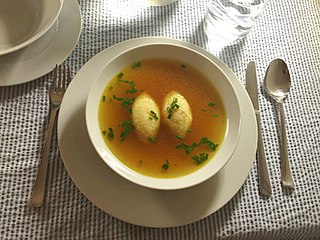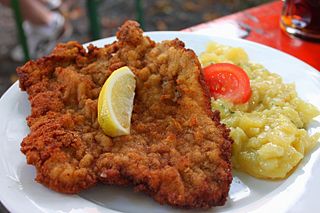
The cuisine of Germany consists of many different local or regional cuisines, reflecting the country's federal history. Germany itself is part of the larger cultural region of Central Europe, sharing many culinary traditions with neighbouring countries such as Poland and the Czech Republic. In Northern Europe, in Denmark more specifically, the traditional Danish cuisine had also been influenced by German cuisine in the past, hence several dishes being common between the two countries.

A sausage is a type of meat product usually made from ground meat—often pork, beef, or poultry—along with salt, spices and other flavourings. Other ingredients, such as grains or breadcrumbs, may be included as fillers or extenders.

Bratwurst is a type of German sausage made from pork or, less commonly, beef or veal. The name is derived from the Old High German Brätwurst, from brät-, finely chopped meat, and Wurst, sausage, although in modern German it is often associated with the verb braten, to pan fry or roast. Beef and veal are usually incorporated amongst a blend often including pork. Beef or veal is usual in halal and kosher Bratwurst sausages, which never include pork for religious reasons.

Polish cuisine is a style of food preparation originating in and widely popular in Poland. Due to Poland's history, Polish cuisine has evolved over the centuries to be very eclectic, and shares many similarities with other national cuisines. Polish cooking in other cultures is often referred to as à la polonaise.

Danish cuisine originated from the peasant population's own local produce and was enhanced by cooking techniques developed in the late 19th century and the wider availability of goods during and after the Industrial Revolution. Open sandwiches, known as smørrebrød, which in their basic form are the usual fare for lunch, can be considered a national speciality when prepared and garnished with a variety of ingredients. Hot meals are typically prepared with meat or fish. Substantial meat and fish dishes includes flæskesteg and kogt torsk with mustard sauce and trimmings. Ground meats became widespread during the industrial revolution and traditional dishes that are still popular include frikadeller, karbonader and medisterpølse. Denmark is known for its Carlsberg and Tuborg beers and for its akvavit and bitters, but amongst the Danes themselves imported wine has gained steadily in popularity since the 1960s.

Weißwurst, literally 'white sausage'; Bavarian: Weißwuascht) is a traditional Bavarian sausage made from minced veal and pork back fat. It is usually flavored with parsley, lemon, mace, onions, ginger and cardamom, although there are some variations. Then the mixture is stuffed into pork casings and separated into individual sausages measuring about 10 to 12 centimetres in length and 3–4 cm in thickness.

Austrian cuisine consists of many different local or regional cuisines. In addition to Viennese cuisine, which is predominantly based on the cooking traditions of the Habsburg Empire, there are independent regional traditions in all the states of Austria.

Schnitzel is a thin slice of meat. The meat is usually thinned by pounding with a meat tenderizer. Most commonly, the meat is breaded before frying. Breaded schnitzel is popular in many countries and is made using veal, pork, chicken, mutton, beef, or turkey. Schnitzel originated as wiener schnitzel and is very similar to other breaded meat dishes.
Romanian cuisine is a diverse blend of different dishes from several traditions with which it has come into contact, but it also maintains its own character. It has been influenced mainly by Turkish but also a series of European cuisines in particular from the Balkan Peninsula and Hungarian cuisine as well as culinary elements stemming from the cuisines of Central Europe.

Knackwurst refers to a type of sausage of northern German origin from the mid-16th century. The many available varieties depend on the geographical region of their production.

Czech cuisine has both influenced and been influenced by the cuisines of surrounding countries and nations. Many of the cakes and pastries that are popular in Central Europe originated within the Czech lands. Contemporary Czech cuisine is more meat-based than in previous periods; the current abundance of farmable meat has enriched its presence in regional cuisine. Traditionally, meat has been reserved for once-weekly consumption, typically on weekends.

Gelbwurst, meaning “yellow sausage”, is a traditional sausage and deli meat from Bavaria, Germany.

Hungarian sausages are sausages found in the cuisine of Hungary. Hungary produces a vast number of sui sausage types. They may be boiled, fresh or dried, and smoked, with different spices and flavors, "hot" or "mild". Many were influenced by their neighbors and brethren.

Bavarian cuisine is a style of cooking from Bavaria, Germany. Bavarian cuisine includes many meat and Knödel dishes, and often uses flour. Due to its rural conditions and Alpine climate, primarily crops such as wheat, barley, potatoes, beets, carrots, onion and cabbage do well in Bavaria, being a staple in the German diet.

Wollwurst is a speciality similar to Weißwurst made from veal and pork. These sausages are also called "Nackerte", "Geschwollene", "Geschlagene" or "Oberländer" and are usually longer and thinner than Weißwürste.

A Frankfurter Würstchen is a thin parboiled sausage in a casing of sheep's intestine. The flavour is acquired by a method of low temperature smoking. For consumption, Frankfurters are occasionally not boiled; they are heated in hot water for only about eight minutes to prevent the skin from bursting. They are also commonly grilled over propane or charcoal flame. They are traditionally served with bread, mustard, horseradish and/or potato salad.

Franconian cuisine is an umbrella term for all dishes with a specific regional identity belonging to the region of Franconia. It is a subtype of German cuisine with many similarities to Bavarian cuisine and Swabian cuisine. It is often included in the Bavarian cuisine, since most parts of Franconia belong to Bavaria today. There are several Franconian food items that are also famous beyond the borders of Franconia, such as Nürnberger Lebkuchen, Bratwurst and the wines of Franconia. Franconia is also famous for its beer and harbours the highest density of breweries in the world.

















